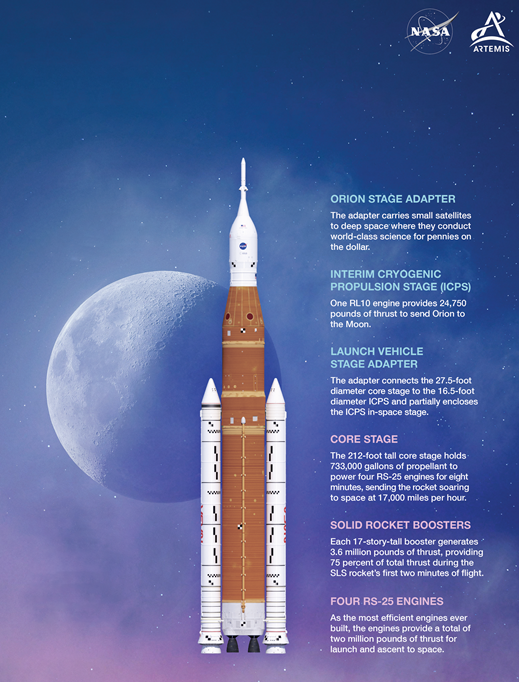The United States "Artemis" plans to return to the moon, and the global manned moon climbing upsurge is resurrected
Author:Global Times Time:2022.08.27
[Global Times Special Reporter Chenyang] As the National Aeronautics and Space Agency (NASA) was determined to launch a "Space Launch System (SLS)" heavy rocket on August 29, the US return to the moon is about to take a key step. At the same time, China also officially announced that around 2030 has the ability to land on the moon, this series of moves have caused a new round of manpower to land on the moon globally.
American "Artemis" plan to return to the moon

American "Space Launch System" Rocket
According to the United States Cable Television News Network, NASA confirmed that SLS Rockets and the "Orion" spacecraft equipped were ready. If there is no technical failure or unfavorable weather conditions in the final link, the SLS Rockets will fire at 8:33 on the 29th local time on the 29th to 10:33. "Si 1" unattended flight test task.
The key first step is to take
According to the official website of NASA, the United States returns to the Moon Plan "Artemis", which is taken from the name of the Moon Goddess in Greek mythology, which echoes the name of the "Apollo" plan that year.
SLS heavy rockets and "Orion" spacecraft combinations for the "Artemis 1" mission have been transported to the launch pad of the Kennedy Space Center in Florida on August 17. SLS is known as one of the most powerful rockets ever, which is comparable to the "Saturn V" heavy rockets used by the "Apollo" plan that year. After being equipped with the "Orion" spacecraft, the height of the combination is close to 100 meters, which is higher than the Liberty Statue in New York. According to reports, as the core equipment of the "Artemis" plan, SLS can send more than 27 tons of valid loads to the moon orbit. After upgrading in the future, it will be increased to more than 46 tons.
If everything goes well, the SLS Rockets will send the "Orion" spacecraft to about 3700 kilometers of rail height, and then the "Orion" spacecraft will be separated from the rocket -level arrow, ignites the pusher to the moon, and then return to the earth after a week around the moon. In this task, its longest distance from the earth will reach 450,000 kilometers, "it will fly farther than any spacecraft built for humans." The entire mission is expected to last 42 days, and the spacecraft will return to Earth on October 10 and fall into the Pacific Ocean near California.
One of the main goals of the "Artemis 1" mission is to test the insulation cover of the "Orion" spacecraft, because the spacecraft will re -enter the atmosphere at the "unprecedented speed". The US "space" website said that it will enter the earth atmosphere at a rate of more than 40,000 kilometers per hour and must withstand the high temperature test of 2800 degrees Celsius.
In this flight, NASA will also test the key systems in the deep space environment, especially the crew's life support system and navigation system. The "Orion" spacecraft is equipped with 3 astronaut models. They are equipped with sensors and can collect a variety of data including radiation doses. Because the position of the "Orion" spacecraft running far exceeding the scope of common communication and navigation systems such as GPS systems, it must keep in touch with the earth through a special deep -space network.
The third launch realizes the moon landing
If the "Artemis No. 1" mission is successful, NASA is expected to start the "Artemis 2" manned by the Month of the Moon in 2024. NASA said that "Artemis 2" will use the same SLS rocket as the first launch, but it will send the "Orion" spacecraft to a slightly different wound track and Test the key system of "Orion" spacecraft.
The "Space" website said that the "Artemis 3" mission will truly realize the manned lunar moon, which may be launched in 2025. If it succeeds, this will be the first time that humans have surpassed the near -ground orbit since the return of the "Apollo 17" astronauts in 1972. However, whether the plan can be realized on schedule, it depends on many unknown factors: the first two tasks, the development progress of the new cabin's space suit, and the availability assessment of the manned landing system. For example, the astronauts will live on the surface of the moon for a week, and they must develop off -space clothes that can protect the spacemen in the environment of high -radiation dose for a long time, but NASA acknowledges that the development of the space service is far lower than expected Essence

The "Orion" spacecraft is connected with the "portal" space station.
In the "Artemis 3" mission, the "Orion" spacecraft will be equipped with 4 astronauts, two of them take the manned landing system developed by SpaceX to land on the surface of the moon, and the other two stay on the spacecraft along the moon orbit along the moon track. flight. According to the plan, the lunar spacerist will stay on the surface of the moon for 6.5 days, which is twice the longest staying time of the astronauts in the "Apollo" plan. They will conduct four "moon strolls", but unlike the "Apollo" plan, these astronauts can only walk because there is no moon rotation car on this moon landing list.
In addition, NASA identified 13 candidate landing areas of the "Artemis 3" mission on August 19, and each area had multiple potential landing sites. These areas are located near the Moon Antarctic. NASA said that all areas of scientific significance are close to the Moon Antarctic, which is a permanent shadow area containing rich resources and not being explored by humans. Future plan is more challenging
According to NASA's plan, the "Artemis" plan does not simply complete the manned moon landing, but the intention is to allow humans to settle around the moon and the moon permanently. The complete "Artemis" plan includes six major components: SLS Rockets, "Orion" manned spacecraft, exploring ground systems, "portal" lunar track space stations, manned moon landing systems and "Artemis base camp" moon. base. Among them, the "portal" lunar rail space station will not only serve as a transfer station for human beings, but also serve the future landing of Mars. In the original design of NASA, the "Orion" spacecraft transported astronauts to the "portal" space station first, and then switched to the manned landing system and landed on the moon; when returning from the moon surface, first transferred at the "portal" space station, and then changed to change Return to the earth by "Orion". However, Luowero, deputy director of NASA in 2020, said that because the development progress of the "portal" space station is far behind expectations, "it will no longer exist on the key path of the 2024 monthly mission."
The huge changes brought by the "portal" space station are just one of the evil results brought by the progress of the "Artemis" plan. The United States reports criticized that the plan's large amount of immature technology and excessive progress will make it face additional risks. For example, the first three "Artemis" tasks are performed in order, and any delay in any task will have a chain reaction to the subsequent tasks. In addition, the cost of the "Artemis" plan is seriously exceeded and the progress is slow. It is estimated that from fiscal 2012 to 2025, NASA will spend $ 93 billion for the "Artemis" plan; fiscal 2021 to 2025, it will cost $ 53 billion. In particular, the single launch cost of the SLS rocket exceeded $ 4 billion, and even the wealthy United States is difficult to bear. The US Supervisor's Office responsible for the NASA project describes the SLS project as "unsustainable" in the report.
Multi -nation Promoting Login Moon Plan
Unlike the United States insisted on using the "Artemis" plan as a symbol of national strength, many countries value the huge business value of the development of the moon, and have devoted themselves to the upsurge of landing on the moon. Including Australia, Canada, Italy, Japan, Luxembourg, the UAE, and the United Kingdom have joined the "Artemis" plan, and hopes to confirm the ownership of the mining of moon mineral resources. Among them, the Japanese government announced in May that the first Japanese astronauts landed on the moon as an important part of cooperation with the United States to promote the "Artemis" plan.
Although the Soviet Union failed in the manned landing of the Cold War, Russia never gave up the dream of the manned landing on the moon. In 2018, Russia envisaged the use of the "Yinisse" heavy rocket as a key carrier -loading tool for manned moon landing and building a lunar base. Its lunar track transportation capacity is at least 20 tons to meet the needs of the Russia's next -generation "Eagle" manned spacecraft into the lunar orbit in 2030. After Russia announced the suspension of the technical design of the "Yinisse" heavy rocket, Russia's manned moon landing project was renamed by several "Angara-A5" large rockets. They plan to launch multiple times, and send the manned spacecraft, the moon landing system and space tugboats to the near -ground track, and then implement the moon after the orbit docking.
India is also interested in the moon landing of the moon. The Indian Space Research Organization announced that it will launch the "Monthly Ship 3" detector next year, at the same time accelerate the training of Chinese astronauts and realize the ability to independently send astronauts into space. The person in charge of the Indian Space Research Organization clearly stated that "it is concerned about the mission of the manned lunar moon."
China will have the ability to land on the moon in 2030
As the American SLS Rockets are about to launch, many foreign media also pay attention to "China will have the ability to land on the moon in 2030." The "Space" website quotes China Aerospace Science and Technology Group as saying that China is developing a new generation of manned carrier rockets and heavy -duty carrier rockets. These rockets will undertake tasks such as manned lunar landing, Mars detection, Jupiter detection, and asteroid detection. Among them, the new generation of manned carrier rocket will have the ability to send the Chinese to the moon around 2030; after the successful development of heavy carrier rockets, it will increase the launch capacity of the China Languard Monthly Monthly to 50 tons to support the development of the moon; at present The development of a series of reused use of aerospace transportation systems will greatly improve China's ability to enter space, reduce the cost of entering space, and help the future development of aerospace transportation.
China Moon Research Station has received high attention from the outside world. Wu Weiren, chief designer of the lunar exploration engineering and academician of the Chinese Academy of Engineering, previously revealed that the fourth phase of the lunar exploration project has been formally established at the end of 2021 and entered the implementation stage. He mentioned: "The main goal of the fourth phase of the lunar exploration project is to carry out scientific detection of the moon's Antarctica and establish the basic type of the moon scientific research station. The subsequent tasks will be implemented in three tasks, namely Chang'e 6, Chang'e VII and Chang'e Eighth Eighth. The plan is planned to be completed by 2030. The current development work is progressing smoothly. "The Russian" Viewpoint "said that China and Russia signed a cooperation project agreement for the International Moon Scientific Research Station in March this year. This project is a comprehensive scientific experimental base that can run independently for a long time. It aims to conduct a variety of scientific research activities such as the moon's own exploration and utilization, and moon -based observations. The International Moon Research Station has a total of three construction stages. During this period, China and Russia first launched the lunar exploration activities and built the moon space station on the surface of the moon and the moon, which eventually enabled the scientific research station to fully put in operation. It is estimated that by 2035, systems such as energy, communications, navigation, remote transportation, and heaven and earth rounds will be completed.
- END -
A helicopter in the United States crashed, and all 6 people on board were unfortunately killed

Jimu Journalist Hu XiuwenAccording to a report by the United States Cable Televisi...
The century -old gun control method has been overthrown in New York State launched a new measure for gun control measures

Xinhua News Agency, Beijing, July 2nd. New York State Governor Cathy Hochro signed...